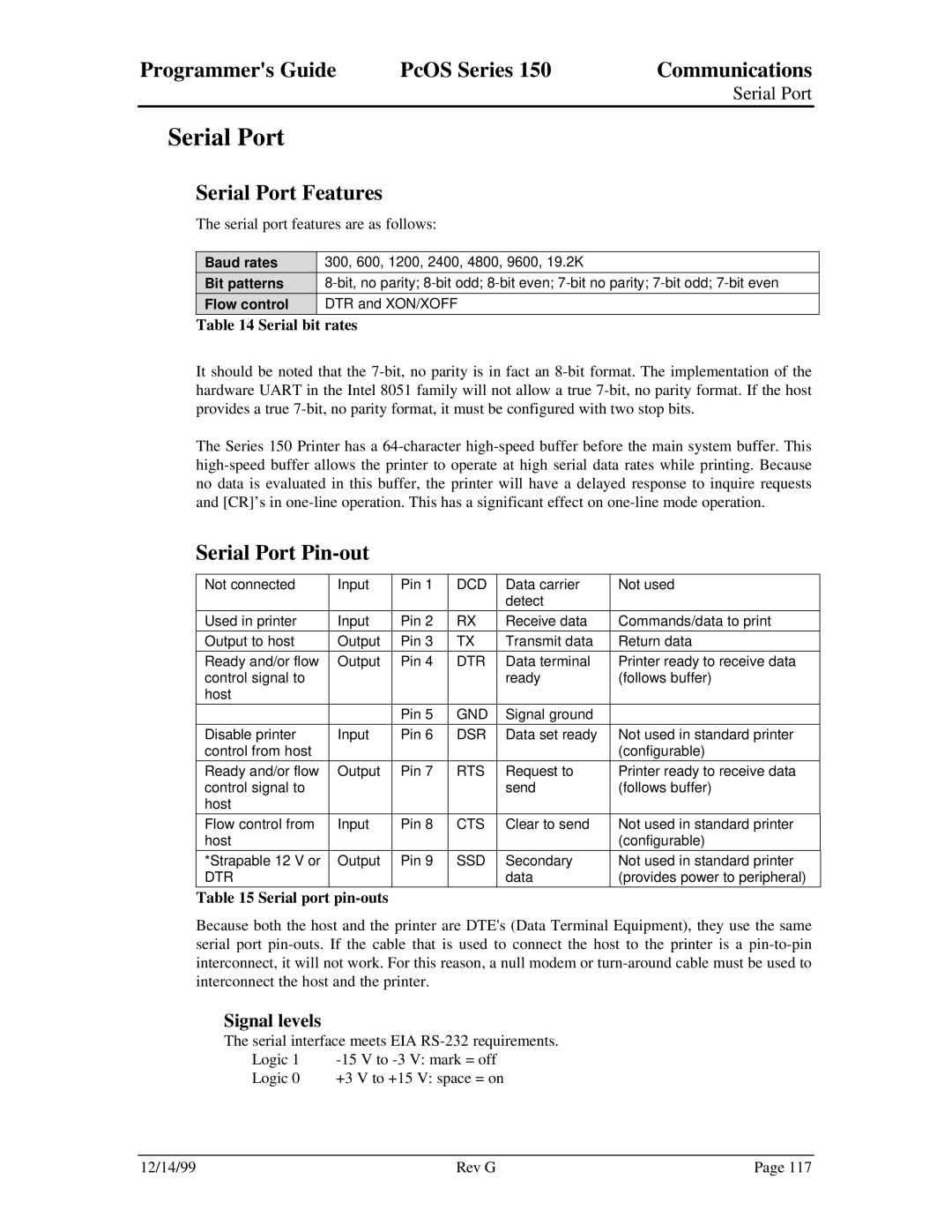Programmers Guide
Page
Programmer’s Guide PcOS Series
Change History
Copyright
Disclaimer
Disclaimer PcOS Series
Table of Contents
Table of Contents PcOS Series
Programmers Guide PcOS Series
Table of Figures
Table of Figures
Page
What is in this book?
Warranty Information
Chapter Overview of the Series 150 Printer
Overview PcOS Series
Where can you find more information?
Contacting Ithaca Peripherals
Chapter General Description
Standard Features
Series 150 Models
Model 154 Receipt/Validation Printer
Model 151 Receipt Printer
Model 152 Receipt/Journal Printer
Model 153 Receipt/Journal/Validation Printer
Printing Specifications
Chapter General Specifications
Programmers Guide PcOS Series 150 General Specifications
Character Generation
General Specifications
General Specifications
Electrical Characteristics
Physical Specifications
Receipt Paper
Media Specifications
Interface Specifications
Ribbon
Validation Forms Printing
Printable Area
Receipt/Journal Paper
Receipt Printing
Validation Left-side Insertion
Validation Top Insertion
Nomenclature
Chapter Control Codes Overview
Control Codes Overview PcOS Series
Epos Emulation
Programmers Guide PcOS Series 150 Control Codes Overview
Standard Emulation
Ipcl Codes
Telpar Emulation
Tables and Charts
Application Development
NCR2567 Emulation
Low-level Paper Motion Control
Chaper Printer Control Codes
Print/Paper Motion
Programmers Guide PcOS Series Control Codes
Horizontal Motion Control
Control Codes PcOS Series
Horizontal Motion
Increments
Vertical Motion Control
Control Codes
Function Vertical tab
Function Set form length in lines
Character Font
Function Begin 90 rotated font
International Character Sets and Code Pages
Country Code Epson Language Set
Language
Ascii
Function Select character code
Character Code
Function Character font image download
IBM
Euro Character Substitution Matrix
NLQ HSD
Character Print Control
Examples of character print
Character Pitch
Pitch Spacing
Character Pitch
Performs an auto print
Character Attribute Commands
Character Attributes
PcOS Series Control Codes
Function Begin underline
Ascii ESC F
Function Select superscript
Function End italics
Number lines per inch
Print Rotation Commands
Rotated Print
Function Begin 270 rotated print
Function End rotated print
Function Set rotated print line spacing
Standard APA Graphics
Graphic Mode
Graphic Mode
Function Begin unidirectional print
Bar codes
EAN-8
Function Bar code height
Receipt Paper Out Sensor
Validation Operation
Validation Operation Control
Function Set left/right print margin
Miscellaneous Control
Miscellaneous Control
Function Print suppress and data pass through
Function Enable Dynamic Response
Printer Status Set/Inquire
Parallel, Non-IEEE 1284 Mode Inquire
Parallel, Ieee 1284 Mode Inquire
Serial Mode Inquire
Dynamic Response Mode
Programmers Guide PcOS Series Control Codes
Inquire Commands
Function Inquire form position sensor status
Function Request printer reset
Function Inquire printer state
Function Inquire all printer status
Function Inquire printer ID
ACK
Extended Diagnostic Commands
Real-time Status
Epos Command Summary
Command Comment Description
Epos Codes
ESC
Epos Codes
Epos Deviations
Command Descriptions
Epos Deviations
Function Enable/disable panel buttons
Function Set bar code
Bell
Microline Command Summary
Command Description
Microline Codes
Communication Echo Mode Serial interface only
Control codes used in line spacing
Star Command Summary
Command Description Control codes used in character setting
Star Codes
Other control codes
Control codes used for graphic printing
ESC a
Control codes used for peripheral units
ETB
NCR Command Summary
NCR2567 Codes
DLE
Telpar Codes
Telpar Command Summary
Normal Second Hex Code Ipcl equivalent Description
Control Codes Summary by Code
Code Field
ESC 1BH,3EH
ESC 1BH,3AH
ESC 1BH,3CH
1BH,3DH
ESC 1BH,5FH
ESC 1BH,5AH
ESC 1BH,5DH
ESC 1BH,5EH
1BH,7EH
Vertical motion
Control Codes Summary by Function
Programmers Guide
Code Field Print/paper motion
Character attributes
International Character Sets
Custom characters
Character pitch
Graphics
Rotated print
Validation control
Diagnostics
Bar codes
4AH
Chapter Operator Panel Controls
Push Buttons Momentary Switches
Indicators
Green Red Indicator
Operator Panel Controls PcOS Series
Fault Indicators
Self test
Level 0 Diagnostics
Extended Diagnostics
Chapter Product Self-tests
Hex-dump Mode PcOS Series
Chapter Hex-dump Mode
Enable Remote Configuration
Chapter Configuration Mode
Initial Power on
Manual Configuration13
Epos Microline
Feature Configuration
Configuration Mode PcOS Series
General Recommendation
Programmers Guide PcOS Series Configuration Mode
Rev G 12/14/99
Character
Vertical Control
Configuration Mode PcOS Series
USA
Configuration Mode PcOS Series Programmers Guide
XON/XOFF
DTR/RTS
Options
General Control
Configuration Mode PcOS Series
Character
Vertical Control
Interface
Save Changes
Options
Overview
Chapter Communications Protocol and Print Buffers
Overview
Communications PcOS Series
Programmers Guide PcOS Series
Parallel Port Protocol
Parallel Port
Parallel Port Inquire Ieee
Printer Buffer Size
Communications PcOS Series
Time-out
PE to ENQ request timing
Parallel Port Inquire Non-IEEE
Parallel Port Plug and Play
Signal Levels
Parallel Port Connector
Serial Port
Serial Port Features
Serial Port Pin-out
Serial Port Protocol
Serial Port Flow Control Using DTR
XON/XOFF
Serial buffer operation
Print Buffer Flow
Programmers Guide PcOS Series
Print controller using data
Printer Buffer Size
Inquire flow
Serial Port Inquire
Reset in Parallel Mode
Remote Printer Reset
Power-cycle Recovery
Reset in Serial Mode
Programmer’s Notes
Function Drawer
Interface Connectors
Chapter Cash Drawer Interface
Interface Description
Character Graphics
Chapter Printing Graphics
Printing Graphics PcOS Series
Printing Graphics
Receipt with APA graphics
APA Graphics
0100
Programmer’s Guide
Epson ID
Appendix a Language Tables
Programmers Guide PcOS Series 150Appendix a
Code Country Code Decimal Hex
3H,0FCH
Appendix a PcOS Series
ECMA-94
3H,0FAH
Programmer’s Guide PcOS Series Appendix B
Appendix B Ascii Code Chart
General Information
Appendix C Ordering Cables
Appendix C PcOS Series
Programmers Guide PcOS Series Index
Index
Index PcOS Series
APA graphic file 124 Ascii Chart 129
PcOS Series
Insert PN Rev G 12/14/99
